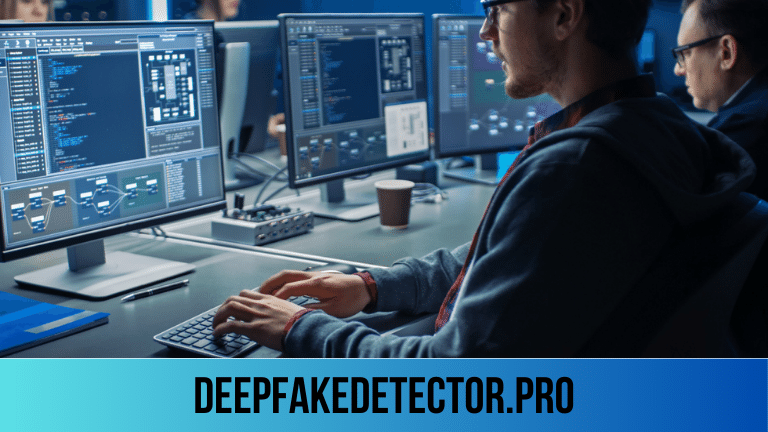How to Implement a DeepFake Detector for Your Organization? As deepfake technology continues to advance, it has become increasingly challenging to distinguish these fabricated media from authentic content, posing a severe threat to trust and credibility.
Implementing a robust deepfake detection system is crucial for organizations to safeguard their reputation, protect their intellectual property, and maintain the integrity of their digital assets. In this comprehensive guide, we’ll explore the importance of deepfake detection, the different approaches to detecting deepfakes, and the steps organizations can take to implement an effective deepfake detector tailored to their specific needs.
Understanding the Deepfake Threat
Before delving into the implementation of a deepfake detector, it’s essential to grasp the magnitude of the deepfake threat and its potential consequences for organizations.
The Rise of Deepfake Technology
Deepfake technology has evolved rapidly in recent years, thanks to advancements in artificial intelligence, particularly in the areas of machine learning and neural networks. These techniques enable the creation of highly realistic synthetic media by training algorithms on vast datasets of images, videos, and audio recordings.
While deepfake technology has legitimate applications in fields like entertainment, education, and research, it has also been exploited for malicious purposes, such as:
- Spreading Misinformation and Propaganda: Deepfakes can be used to create fake videos or audios of public figures, politicians, or influencers, disseminating false narratives and manipulating public opinion.
- Defamation and Harassment: Deepfakes can be employed to create compromising or explicit content, posing a significant threat to an individual’s or organization’s reputation and privacy.
- Financial Fraud: Deepfake audio and video can be used to impersonate individuals, potentially leading to financial fraud, identity theft, or unauthorized access to sensitive information.
- Corporate Espionage and Intellectual Property Theft: Deepfakes can be leveraged to gain unauthorized access to confidential data, trade secrets, or proprietary information, posing a severe risk to businesses and organizations.
As deepfake technology continues to evolve and become more accessible, the potential for misuse and the associated risks increase, making it imperative for organizations to implement robust detection and mitigation strategies.
The Impact on Organizations
The consequences of deepfake attacks can be severe and far-reaching for organizations, including:
- Reputational Damage: Deepfake content involving organizations, their employees, or stakeholders can significantly tarnish their reputation, erode public trust, and negatively impact their brand image.
- Financial Losses: Deepfake-enabled fraud, intellectual property theft, or operational disruptions can result in substantial financial losses for organizations.
- Legal Liabilities: Organizations may face legal liabilities if they fail to take reasonable measures to detect and mitigate deepfake threats, particularly in cases involving defamation, privacy violations, or financial fraud.
- Erosion of Trust: The proliferation of deepfakes can undermine public trust in digital media and online information, potentially impacting an organization’s ability to communicate effectively with its stakeholders and customers.
By implementing an effective deepfake detection system, organizations can proactively address these threats, protect their assets, and maintain the integrity of their digital presence.
Approaches to Deepfake Detection
Several techniques and approaches have been developed to detect deepfakes, each with its strengths and limitations. Understanding these approaches is crucial for organizations to choose the most appropriate solution for their specific needs.
Visual Analysis
Visual analysis techniques focus on identifying artifacts, inconsistencies, or anomalies in the visual components of deepfake media, such as images or videos.
- Pixel-Level Analysis: This approach examines the pixel-level patterns and irregularities in images or video frames, looking for signs of manipulation or synthetic generation. Techniques like error level analysis, noise analysis, and compression analysis can be employed.
- Facial Analysis: Facial analysis techniques leverage machine learning models trained on large datasets of authentic facial images to detect irregularities or inconsistencies in facial features, expressions, or movements that may indicate deepfake manipulation.
- Biological Signal Analysis: Some deepfake detection methods analyze biological signals, such as eye blinking patterns, pupil dilation, or subtle facial muscle movements, which can be challenging to replicate accurately with current deepfake techniques.
- Temporal and Spatial Inconsistencies: Deepfake videos may exhibit temporal or spatial inconsistencies, such as inconsistent lighting, shadows, or background artifacts, which can be detected through advanced computer vision and image processing techniques.
While visual analysis methods can be effective, they may struggle with high-quality deepfakes or when the manipulation is subtle or targeted to specific regions of the media.
Audio Analysis
Audio analysis techniques focus on detecting irregularities or inconsistencies in the audio components of deepfake media, such as speech or other sounds.
- Speech Synthesis Detection: These methods aim to identify synthetic or manipulated speech by analyzing acoustic features, such as pitch, formant frequencies, and spectral characteristics, which can differ from natural human speech.
- Voice Biometrics: Voice biometric techniques leverage machine learning models trained on large datasets of authentic voice samples to detect inconsistencies or anomalies in the speaker’s voice patterns, prosody, or vocal characteristics.
- Audio Artifact Analysis: Deepfake audio may exhibit artifacts or irregularities resulting from the synthesis or manipulation process, such as background noise, spectral distortions, or unnatural transitions, which can be detected through advanced signal processing techniques.
- Multi-Modal Analysis: Some approaches combine audio analysis with visual cues, such as lip movements or facial expressions, to detect inconsistencies between the audio and visual components of deepfake media.
While audio analysis techniques can be effective, they may struggle with high-quality deepfake audio or when the manipulation is targeted to specific segments or speech patterns.
Hybrid Approaches
Hybrid approaches combine multiple detection techniques, leveraging both visual and audio analysis, as well as other contextual information and metadata.
- Multi-Modal Fusion: These techniques fuse information from various modalities, such as visual, audio, and text, using machine learning models to detect inconsistencies or anomalies across multiple dimensions.
- Metadata Analysis: Deepfake media may exhibit irregularities or inconsistencies in the associated metadata, such as timestamps, geolocation data, or file properties, which can be analyzed to detect potential manipulation.
- Contextual Analysis: Contextual information, such as the source of the media, the individuals involved, or the surrounding narrative, can be analyzed to identify potential deepfake content based on inconsistencies or irregularities.
- Ensemble Methods: Ensemble methods combine multiple detection techniques, leveraging the strengths of each approach to improve overall accuracy and robustness.
Hybrid approaches can be more effective in detecting complex or multi-modal deepfakes, but they may require more computational resources and larger training datasets.
Emerging Techniques
As deepfake technology continues to evolve, researchers and organizations are actively exploring new and innovative techniques for detection, including:
- Adversarial Training: This approach involves training deepfake detection models using adversarial examples, where synthetic data is iteratively generated and used to improve the model’s robustness against new types of deepfakes.
- Self-Supervised Learning: Self-supervised learning techniques leverage the vast amount of unlabeled data available on the internet to train deepfake detection models without relying on labeled datasets, potentially improving scalability and generalization.
- Explainable AI: Explainable AI (XAI) techniques aim to make deepfake detection models more transparent and interpretable, allowing for better understanding of the decision-making process and potential failure modes.
- Blockchain and Distributed Ledgers: Blockchain and distributed ledger technologies can be leveraged to create tamper-proof audit trails for digital media, enabling the verification of authenticity and provenance.
While these emerging techniques show promise, they are often in early stages of development and may require further research and validation before widespread adoption.
Implementing a Deepfake Detector
Implementing an effective deepfake detector for your organization involves a multi-step process that encompasses various considerations, including your specific requirements, available resources, and the potential risks and consequences of deepfake attacks.

FAQs
1. What is a DeepFake detector and why is it important for my organization?
A DeepFake detector is a software tool designed to identify and flag manipulated or synthetic media content created using deep learning techniques. This is important for organizations to prevent the spread of misinformation, protect the integrity of communications, ensure the authenticity of media assets, and safeguard against potential threats such as fraud and reputational damage.
2. What are the key steps to implement a DeepFake detector in my organization?
To implement a DeepFake detector, follow these key steps:
Assessment: Evaluate the need for a DeepFake detector and the specific use cases within your organization.
Research: Investigate available DeepFake detection technologies and tools, including open-source options and commercial solutions.
Integration: Integrate the chosen DeepFake detection tool with your existing systems and workflows.
Training: Train your staff on how to use the DeepFake detector and interpret its results.
Monitoring and Updating: Continuously monitor the effectiveness of the DeepFake detector and update it as needed to counter new types of DeepFake techniques.
3. What tools and technologies are available for DeepFake detection?
Several tools and technologies are available for DeepFake detection, including:
Deepware Scanner: A tool for scanning media files to detect DeepFakes.
Microsoft Video Authenticator: Developed by Microsoft to analyze still photos and videos to provide a confidence score about the likelihood of manipulation.
FaceForensics++: A comprehensive dataset and benchmark for face manipulation detection.
DeepFake Detection Challenge (DFDC) dataset: A dataset provided by Facebook to encourage the development of detection algorithms.
Custom AI Solutions: Many organizations opt to develop custom AI solutions tailored to their specific needs, often using frameworks like TensorFlow or PyTorch.
4. How can we ensure the effectiveness of the DeepFake detector?
Ensuring the effectiveness of a DeepFake detector involves several strategies:
Regular Updates: Keep the detection software and its underlying models updated to recognize the latest DeepFake techniques.
Data Quality: Use high-quality and diverse datasets for training and testing the detector.
Continuous Monitoring: Regularly monitor the detector’s performan
5. What are the potential challenges in implementing a DeepFake detector, and how can we address them?
Some potential challenges in implementing a DeepFake detector include:
Rapid Evolution of DeepFake Technology: DeepFakes are constantly evolving, which can make it difficult for detectors to keep up. Address this by ensuring regular updates and continuous research.
False Positives/Negatives: Detection tools may sometimes incorrectly flag legitimate content or miss DeepFakes. Mitigate this by combining automated detection with human oversight and continually refining the detection models.
Integration Issues: Integrating the detector with existing systems can be complex. Overcome this by thoroughly planning the integration process and involving IT professionals.
Privacy Concerns: Ensure that the implementation respects user privacy and complies with relevant data protection regulations.
Resource Requirements: Developing and maintaining an effective DeepFake detector can require significant resources. Address this by leveraging available tools and technologies and prioritizing key areas for implementation.

